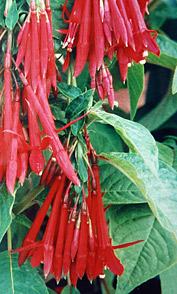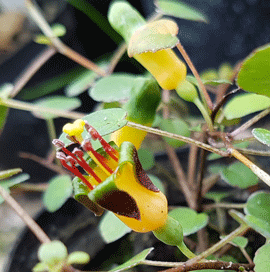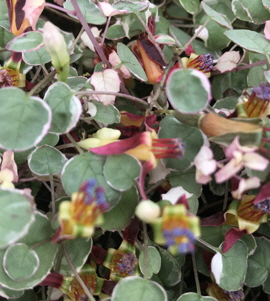|
|
SPECIES (TYPES) |
|
|
|
|
|
F. Arborescens. 1826 (Sims).Flowers same form as lilac. Clusters of small lilac blooms. Very fast upright grower. |
|
|
|
|
F. Boliviana. Single. Tube blood-red, extremely long, funnel shaped. Corolla blood-red shortish. Extremely large, medium to dark-green hairy foliage with reddish veins. Flowers borne in clusters. Very vigorous upright grower. |
|
|
|
|
F. Boliviana var. Luxuriana "Alba". Tube white. Corolla blood red. This magnificent plant has extra long flowers, the white tube contrasting starkly with the short red corolla. |
|
|
|
|
F. Denticulata. 1802 (Ruiz & Pavon). Tube and Sepals long reddish-pink, sepals tipped green. Corolla red. Large dark green foliage with long tubular flowers. Strong upright bush, must be pinched out. |
|
|
|
|
F. Fulgens Gesneriana. Long tube light vermilion/red. Sepals yellowish to green with red base. Corolla bright vermilion, extremely attractive long flowers, pendulous and borne at extreme end of branches in clusters. Foliage is light sage green, darker on upper side. One for the collector. |
|
|
|
|
F. Procumbens. (Hardy) 1839 Species. Tube greenish yellow, red at base. Sepals green tipped purple. No Corolla. Stamens bear bright blue pollen. Seed pods turn from green to plum purple and become quite large. Flowers free, very small and points upwards. Growth trailing, suitable for rockeries. 4in (10cm). |
|
|
|
|
F. Procumbens Variegata. (Hardy) Tube greenish yellow. Sepals green tipped, fully reflexed exposing stamens with bright blue pollen. The foliage of the variety is highly variegated, silver green and cream edged with pink distinctive cast. Growth trailing, suitable for rockeries or ground cover. Natural variant of procumbens. |
|
|
|
|
Speciosa. Tube long orange vermilion colouring. Sepals yellowish green with orange base, Corolla orange vermilion. Long attractive flowers. Unusual light green foliage - Upright bush. Extremely vigorous. This is not a true species but an hybrid from F. Splendens and F. Fulgens. |
|
|
|
PLEASE NOTE FOR WINTER MONTHS: H.1. requires greenhouse heated to minimum of 40°F (4.5°C). Although the above classifications are our recommendations, many of our customers are growing fuchsias that we classify as H.2 out of doors with good results and obviously with bigger blooms produced on H.2's than on The RHS and the British Fuchsia Society list many fuchsias that we classify as H2 medium hardy, as H3 hardy and with the climate changes (Global warming) this has probably become a fact |
|
|
|
A B C D E F G H I J K L M N O |
|||





